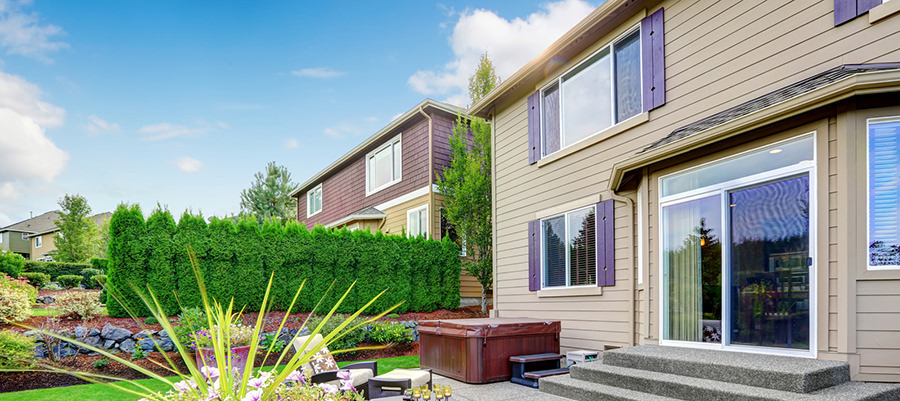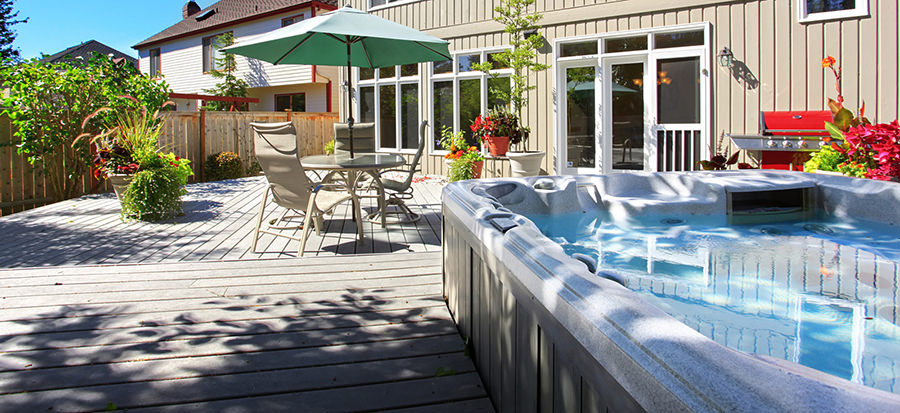
If you have decided that you are going to buy a hot tub then your next job will be to decide where in your garden to put it. Most importantly you will need a firm surface to stand it on and, if you have a brick patio already , this might seem like the perfect solution. But is a brick patio a good place to stand a hot tub? Is it likely to cause any problems or are there any things that you should look out for? Read on to find out!
So, can a hot tub go on a brick patio? Hot tubs can generally go on brick patios. Ensure that the patio is perfectly level and has good foundations to take the weight of a full hot tub. Also check that you have enough space on the patio for access all round the hot tub.
Once all of the details have been worked out and everything has been sufficiently planned you are able to place your hot tub directly on your brick patio. There are some things that can make this an easier process however, like using a paver. On the whole though, placing your hot tub on a brick patio should not cause any significant issues, especially not in the immediate future.
Things You Need To Check Before Putting Your Hot Tub On Your Patio
There are some things that you need to check and plan for before you can place your hot tub on your brick patio. The first thing that you need to measure and plan for is the weight of the water inside the tub. When you check for the weight of your hot tub online a measurement is usually only provided for the hot tub without any water in it. You must try and search for the weight of the tub when it is filled with water.
A tub without water will likely weigh only a few hundred pounds on average, meaning that you can put it practically anywhere, on any surface. Issues start to arise when you fill the tub with water as this can make the hot tub extremely heavy. This subsequently means that more force is placed onto the bottom shell of the hot tub, thus requiring more of a stable surface underneath it to ensure that it is supported at all times. If the surface beneath is not sturdy or reliable then the hot tub can become damaged over time.

Make sure that the bricks in the patio are not loose and that they are firmly mortared in. Check also that the patio has a firm foundation and isn’t just built on the earth as this will sink downwards with the weight of a full hot tub on it. The best foundation is made of thick hardcore which will provide enough strength to carry the hot tub’s weight.
Similarly, another aspect that you need to measure and look out for is the surface’s level underneath the hot tub. It is essential for the surface beneath the hot tub to be completely level, meaning that it must be entirely straight across the length of the patio. If your patio surface is dipping in any way, then it simply cannot be used to house your hot tub.
This is mainly due to the weight of the tub and the water inside. As mentioned just above, if the hot tub’s weight is not fully supported then the tub could become damaged over time. This is especially the case if the patio surface beneath the hot tub is not level as this could cause warping and stretching of the hot tub framework over time. While it may not seem evident at first due to the gradual nature of the damage, you will eventually be left with a hot tub that is damaged beyond repair. This can all be avoided if the patio surface is levelled out prior to placing the hot tub.
There are two more details that cannot be overlooked during the planning stage, the accessibility of the hot tub and its spacing on the patio area. Before you even purchase your hot tub, you should make sure that you know exactly where it is going. You will need to accurately measure out your patio area, ensuring that it is large enough for a hot tub. You will then need to buy a hot tub that sits comfortably in this place.
You do not want to purchase a hot tub that cannot be used so you need to make sure that you can actually access the hot tub from all angles. You must also ensure that the hot tub will have access to the necessary power supply. This may require some additional landscaping work, but you need to ensure that you have long enough power cables that will reach from your power supply to the hot tub. You will also want to make sure that these cables are neatly tucked away, ensuring that they are not a safety hazard for anyone.
Alternatives To Using A Brick Patio
While placing your hot tub on a brick patio is a perfectly viable thing to do, it may not be suitable for some people. Thankfully, there are some alternatives to using a brick patio. These alternatives come in the form of different surface materials that you can place your hot tub on.
Many people choose to build a separate area in their garden specifically for a hot tub. These specially designed areas often attach directly onto a patio area. One of the most popular materials that is used for this is concrete. Concrete is such a popular material for these hot tub add-on areas as it is relatively cheap to use and very easy to model into the shape and size that you want. Additionally, concrete is also very easy to make level. The greatest downside to using concrete is that it simply looks pretty ugly in comparison to other materials.
A somewhat better looking alternative material is that of crushed stone. This material is also relatively inexpensive and takes very little effort to place. By using wooden borders (or something similar) you can easily measure out the exact size and shape you want for your hot tub area. The main issue with using crushed stone is that it does not provide a level surface for your hot tub, therefore being likely to cause some form of damage to your hot tub if it is housed there for a long duration.

The final popular material that is used commonly as an alternative to a brick patio is that of the prefabricated pad. These pads are simple in design but are quite effective, providing a level surface for your hot tub and supporting it thoroughly. These pads can usually be fitted together in a modular fashion (like a jigsaw), allowing you to adapt the size and shape of the hot tub area at your will.
What Is A Paver And Should You Use It?
Whilst it is completely fine to place your hot tub on your brick patio, you may want to purchase a paver to go underneath it. Pavers are essentially a surface layer between your hot tub and the patio. These pavers come in a range of materials such as brick, concrete, and rubber, each come with their own advantages and disadvantages. Generally speaking, using a hot tub paver is quite a good idea as it provides an extra level of durability and support for your hot tub.
Pavers tend to come in a modular design, allowing you to adapt the shape and size of the surface to match your own designs. Pavers can also be easily replaced should they become damaged. This is much better than having to remove an entire section of your patio and repair it. The majority of pavers are also highly absorbent whilst maintaining their high level of durability, ensuring that the surface is not easily damaged or worn down by water. Rubber pavers are probably the most common form due to their high durability, high level of absorption and their inherently high economic value.
Related Questions
Should You Put A Mat Underneath You Hot Tub?Putting a mat or a paver underneath your hot tub is a great idea. In general, placing something beneath your hot tub will provide even more support for your tub, ensuring that it does not become easily damaged or warped over time. Placing something beneath your hot tub can also help with water absorption.
Can You Put A Hot Tub On Grass?Simply put, you should not put your hot tub on grass without anything supporting it underneath. This is for one main reason, the ground beneath the tub simply cannot support its weight. Over time your hot tub may start to sink into the ground and become damaged. Water damage is particularly likely if you just place your hot tub directly onto the grass. A stable and supportive surface beneath the hot tub is required.

